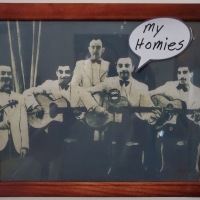DjangoBooks.com
Welcome to our Community!
Categories
- 20K All Categories
- 1.1K General
- 478 Welcome
- 59 Archtop Eddy's Corner
- 146 CD, DVD, and Concert Reviews
- 385 FAQ
- 26 Gypsy Jazz Italia
- 27 Photos
- 207 Gypsy Picking
- 21 Unaccompanied Django
- 15 Pearl Django Play-Along Vol.1
- 17 Gypsy Fire
- 45 Gypsy Rhythm
- 1.4K Gypsy Jazz University - Get Educated
- 131 Gypsy Jazz 101
- 228 Repertoire
- 224 History
- 708 Technique
- 51 Licks and Patterns
- 6 Daniel Givone Manouche Guitare Method Users Group
- 20 Eddie Lang Club
- 1.3K Gypsy Jazz Gear
- 805 Guitars, Strings, Picks, Amps, Pickups and Other Accessories
- 461 Classifieds
- 50 Recording
- 62 Other Instruments
- 18 Violin
- 5 Mandolin
- 22 Accordion
- 7 Bass
- 10 Woodwinds
- 348 Gypsy Jazz Events
- 143 North America
- 110 Europe
- 95 International










Comments
In other words, port or not the rest stays the same?
That would be cool idea to entertain doing someday.
I always thought it's a nice feature on the Park guitar my buddy John has.
I could always hear my own guitar in the loud jams but sometimes during bar gigs the crowd can get so loud to the point of me playing completely relying on memory, can't hear a thing.
Also, some makers put a large oval port on the lower bout near the waist -- look at Breedlove guitars.
Some guitars feel like they're quite quiet from the players point of view, then when you sit in the "line of fire" they sound like a cannon all of a sudden. The ones with the sound port are kind of like the opposite of that, though I'm just generalizing based on the 3 or 4 I've tried.
Maybe no sound port on my guitar then.
That really surprised me a couple of years ago at DiJ when I played Michael's Selmer in a jam and was thinking to myself "wow it's really quiet" and then passed the guitar to someone else and realized it was positively the guitar with the most projection in the room.
http://www.mcknightguitars.com/soundports.html
As easy as drilling an opening or...?
But as long as I'm fairly sure it isn't too detrimental to the projection I'd be willing to do it.
That said thought this whole sound pressure level stuff poses more questions than it gives clear answers for me.
That is when it comes to the perceivable volume and projection of the guitar sound.
I actually wanted to ask that question in a separate thread for a while.
Why?
Because according to the SPL meter, my Martin is as loud as my Ivanovski. Both from a couple of feet and 12 feet of distance.
Yet when you strum the two, there's no question which one is "louder", Ivanovski by far.
I don't know what gives and how do measure and define this loudness but it would seem it is much more subjective than measurable.
To return to the original post, I used D'Addario .012 phosphor bronze strings on my Favino for several years before Argentines were available in the USA. Never had a problem and they sounded just fine.
Guitar buyers tend to be pretty conservative about guitars, and for good reason. Most people don't buy very many top-end guitars in a lifetime, maybe only one or two. So when you spend all that money, you want to be certain that you get exactly what you want. Will's recent post about remaking his custom guitar tells the tale very well. It is usually wealthy collectors who have commissioned builders to experiment. I have tinkered with a lot of guitars over the years; I usually buy an inexpensive one to learn on. I'd cut a sound port in a Saga, but never in my Favino - a mod like a sound port might have a very different effect on an inexpensive factory guitar than on a fine guitar. All pretty complicated...
So - who here knows what the overall effect of changing the length/break angle of a string between the bridge and the tailpiece is; a longer vs a shorter tailpiece? It does something, I'm sure. But what?